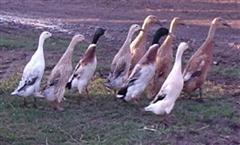Duck - Indian Runner
Scientific Name: Anas platyrhynchos
Tue, 29th April, 2025 - 4:57 am GMT
Sponsor Ads:

Alternative Name
Scientific Name: Anas platyrhynchosBasic Info
Indian Runners are rather small ducks, with drakes weighing under five pounds and ducks weighing less than 4.5 pounds. They are sometimes called the "Bowling-Pin Duck" because of their unique upright posture that some people say resembles a wine bottle. Indian Runners have very long, narrow necks. While most noted for their upright posture, they generally only stand upright when disturbed or running. Indian Runners appear in a variety of colors. The most common shade is the original fawn and white animal, although other possibilities are white, black, brown, blue, gray, trout, buff and silver gray.
Health
Indian Runners should not be kept indoors. They are excellent ducks to keep in a garden, especially one where snails, slugs, insects and worms are available to eat. They can also be fed wheat and bread. Indian Runners should be housed in a large yard with a pond large enough to bathe in. They can usually be confined by a fence about 50cm high, although when frightened they may be able to evade such a low enclosure. Breeding The Indian Runner is capable of laying as many as 300 eggs per year. They are not very broody animals, meaning they do not tend to sit on their eggs until they hatch. For the best results when breeding the Indian Runner, place the eggs under an incubator or in the nest of a broody duck or hen.Habitat
N/ABehavior
The Indian Runner is a lightweight duck that, uniquely, cannot fly. Instead, they are excellent runners and foragers. The Indian Runner is rarely kept as a pet, per se, although they are popular as domestic ducks. While most ducks are known for waddling about, the Indian Runner has upright posture that allows it to run quite quickly instead of waddling as other breeds do. The Indian Runner is a rather nervous and timid animal, although they can be trained with plenty of handling. Like many other ducks, the Indian Runner is not likely to become an affectionate house-pet. The most interaction with humans that Indian Runners usually engage in is responding to offerings of food. Indian Runners are excellent egg-layers, and can lay as many as 300 eggs per year. Many people keep Indian Runners for their egg-laying capabilities, their meat, and their value as an exhibition bird. Indian Runners enjoy water and should always have access to enough water to submerge themselves in. Indian Runners should not be kept indoors, but they are useful in gardens because they eat insects, spiders and slugs and provide good fertilizer.Origin
Southeast AsiaHistory
Most experts believe that the Indian Runner originated in South East Asia and was exported first to France and from there to England in the 19th century. The experts differ on where the animals came from: some people feel the Indian Runner is native to Malaysia, while others believe they came from India. Regardless of their origin, it is known that a sea captain from Whitehaven gave the first exported Indian Runners, which he'd gotten in India, to some friends in the middle of the 19th century. In the 1890s, a man named Henry Digby imported more Indian Runners. The fawn variety of the Indian Runner was first shown in 1876 and the fawn and white variety some years later.Common Foods
insects, spiders and slugsSponsor Ads:
Those who cannot remember the past are condemned to repeat it. -- George Santayana
Duck - Indian Runner
Coded by: BGID® | ALL RIGHTS RESERVED Copyright © 2000-2025
Disclaimer | Privacy | Report Errors / Contact | Credits
















